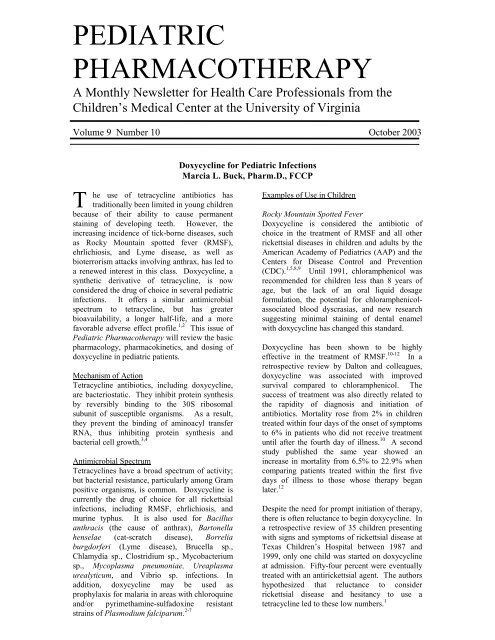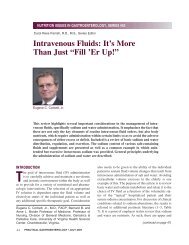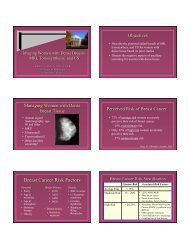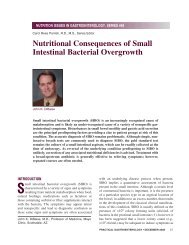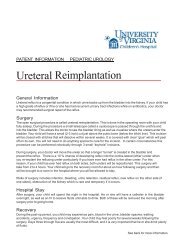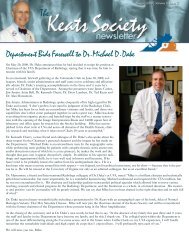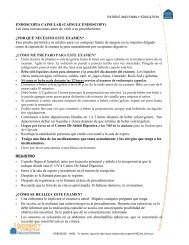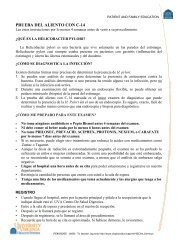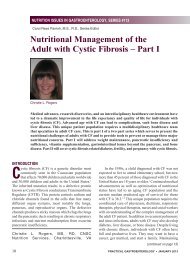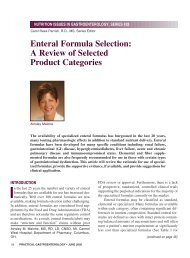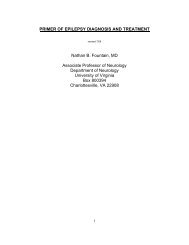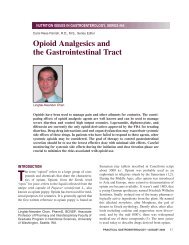10 Doxycycline for Pediatric Infections - Medicine - University of ...
10 Doxycycline for Pediatric Infections - Medicine - University of ...
10 Doxycycline for Pediatric Infections - Medicine - University of ...
Create successful ePaper yourself
Turn your PDF publications into a flip-book with our unique Google optimized e-Paper software.
PEDIATRIC<br />
PHARMACOTHERAPY<br />
A Monthly Newsletter <strong>for</strong> Health Care Pr<strong>of</strong>essionals from the<br />
Children’s Medical Center at the <strong>University</strong> <strong>of</strong> Virginia<br />
Volume 9 Number <strong>10</strong> October 2003<br />
T<br />
he use <strong>of</strong> tetracycline antibiotics has<br />
traditionally been limited in young children<br />
because <strong>of</strong> their ability to cause permanent<br />
staining <strong>of</strong> developing teeth. However, the<br />
increasing incidence <strong>of</strong> tick-borne diseases, such<br />
as Rocky Mountain spotted fever (RMSF),<br />
ehrlichiosis, and Lyme disease, as well as<br />
bioterrorism attacks involving anthrax, has led to<br />
a renewed interest in this class. <strong>Doxycycline</strong>, a<br />
synthetic derivative <strong>of</strong> tetracycline, is now<br />
considered the drug <strong>of</strong> choice in several pediatric<br />
infections. It <strong>of</strong>fers a similar antimicrobial<br />
spectrum to tetracycline, but has greater<br />
bioavailability, a longer half-life, and a more<br />
favorable adverse effect pr<strong>of</strong>ile. 1,2 This issue <strong>of</strong><br />
<strong>Pediatric</strong> Pharmacotherapy will review the basic<br />
pharmacology, pharmacokinetics, and dosing <strong>of</strong><br />
doxycycline in pediatric patients.<br />
Mechanism <strong>of</strong> Action<br />
Tetracycline antibiotics, including doxycycline,<br />
are bacteriostatic. They inhibit protein synthesis<br />
by reversibly binding to the 30S ribosomal<br />
subunit <strong>of</strong> susceptible organisms. As a result,<br />
they prevent the binding <strong>of</strong> aminoacyl transfer<br />
RNA, thus inhibiting protein synthesis and<br />
bacterial cell growth. 3,4<br />
Antimicrobial Spectrum<br />
Tetracyclines have a broad spectrum <strong>of</strong> activity;<br />
but bacterial resistance, particularly among Gram<br />
positive organisms, is common. <strong>Doxycycline</strong> is<br />
currently the drug <strong>of</strong> choice <strong>for</strong> all rickettsial<br />
infections, including RMSF, ehrlichiosis, and<br />
murine typhus. It is also used <strong>for</strong> Bacillus<br />
anthracis (the cause <strong>of</strong> anthrax), Bartonella<br />
henselae (cat-scratch disease), Borrelia<br />
burgdorferi (Lyme disease), Brucella sp.,<br />
Chlamydia sp., Clostridium sp., Mycobacterium<br />
sp., Mycoplasma pneumoniae, Ureaplasma<br />
urealyticum, and Vibrio sp. infections. In<br />
addition, doxycycline may be used as<br />
prophylaxis <strong>for</strong> malaria in areas with chloroquine<br />
and/or pyrimethamine-sulfadoxine resistant<br />
strains <strong>of</strong> Plasmodium falciparum. 2-7<br />
<strong>Doxycycline</strong> <strong>for</strong> <strong>Pediatric</strong> <strong>Infections</strong><br />
Marcia L. Buck, Pharm.D., FCCP<br />
Examples <strong>of</strong> Use in Children<br />
Rocky Mountain Spotted Fever<br />
<strong>Doxycycline</strong> is considered the antibiotic <strong>of</strong><br />
choice in the treatment <strong>of</strong> RMSF and all other<br />
rickettsial diseases in children and adults by the<br />
American Academy <strong>of</strong> <strong>Pediatric</strong>s (AAP) and the<br />
Centers <strong>for</strong> Disease Control and Prevention<br />
(CDC). 1,5,8,9 Until 1991, chloramphenicol was<br />
recommended <strong>for</strong> children less than 8 years <strong>of</strong><br />
age, but the lack <strong>of</strong> an oral liquid dosage<br />
<strong>for</strong>mulation, the potential <strong>for</strong> chloramphenicolassociated<br />
blood dyscrasias, and new research<br />
suggesting minimal staining <strong>of</strong> dental enamel<br />
with doxycycline has changed this standard.<br />
<strong>Doxycycline</strong> has been shown to be highly<br />
effective in the treatment <strong>of</strong> RMSF. <strong>10</strong>-12 In a<br />
retrospective review by Dalton and colleagues,<br />
doxycycline was associated with improved<br />
survival compared to chloramphenicol. The<br />
success <strong>of</strong> treatment was also directly related to<br />
the rapidity <strong>of</strong> diagnosis and initiation <strong>of</strong><br />
antibiotics. Mortality rose from 2% in children<br />
treated within four days <strong>of</strong> the onset <strong>of</strong> symptoms<br />
to 6% in patients who did not receive treatment<br />
until after the fourth day <strong>of</strong> illness. <strong>10</strong> A second<br />
study published the same year showed an<br />
increase in mortality from 6.5% to 22.9% when<br />
comparing patients treated within the first five<br />
days <strong>of</strong> illness to those whose therapy began<br />
later. 12<br />
Despite the need <strong>for</strong> prompt initiation <strong>of</strong> therapy,<br />
there is <strong>of</strong>ten reluctance to begin doxycycline. In<br />
a retrospective review <strong>of</strong> 35 children presenting<br />
with signs and symptoms <strong>of</strong> rickettsial disease at<br />
Texas Children’s Hospital between 1987 and<br />
1999, only one child was started on doxycycline<br />
at admission. Fifty-four percent were eventually<br />
treated with an antirickettsial agent. The authors<br />
hypothesized that reluctance to consider<br />
rickettsial disease and hesitancy to use a<br />
tetracycline led to these low numbers. 1
Lyme Disease<br />
<strong>Doxycycline</strong> is also the drug <strong>of</strong> choice <strong>for</strong> the<br />
treatment <strong>of</strong> early localized Lyme disease. In<br />
addition, it is <strong>of</strong>ten used in the treatment <strong>of</strong> early<br />
disseminated and late disease. At this time, the<br />
recommendation <strong>for</strong> treatment with doxycycline<br />
is restricted to adults and children greater than 8<br />
years <strong>of</strong> age because <strong>of</strong> the risk <strong>for</strong> dental<br />
staining. Amoxicillin is still considered the drug<br />
<strong>of</strong> choice <strong>for</strong> the treatment <strong>of</strong> younger<br />
children. 7,13,14<br />
Anthrax<br />
In response to bioterrorist activity in 2001, the<br />
CDC published new recommendations <strong>for</strong><br />
postexposure prophylaxis and treatment <strong>of</strong><br />
anthrax infections in children and adults. 15-17 In<br />
these guidelines, cipr<strong>of</strong>loxacin and doxycycline<br />
are considered equivalent agents <strong>of</strong> choice,<br />
regardless <strong>of</strong> patient age. The choice <strong>of</strong> agent<br />
may be based on availability and tolerability;<br />
there is not enough clinical data available in<br />
children to determine the ideal treatment<br />
regimen. In patients with systemic or<br />
inhalational exposure, additional agents may also<br />
be used. Because <strong>of</strong> reports <strong>of</strong> beta-lactam<br />
resistance, penicillins, including amoxicillin, are<br />
no longer recommended as initial therapy, but<br />
may be used when the specific isolate <strong>of</strong> B.<br />
anthracis implicated is determined to be<br />
susceptible. 15,16<br />
Pharmacokinetics<br />
<strong>Doxycycline</strong> is well absorbed after oral<br />
administration, with peak serum concentrations<br />
averaging 3 to 4 mcg/ml within 2 hours <strong>of</strong> a 200<br />
mg oral dose. It is widely distributed throughout<br />
the body, and is 80 to 95% protein bound.<br />
<strong>Doxycycline</strong> is primarily concentrated in the bile.<br />
It is eliminated through the feces and via renal<br />
excretion as unchanged drug. The average rate<br />
<strong>of</strong> clearance in adults is approximately 75 ml/min<br />
with an elimination half-life <strong>of</strong> 18 to 22 hours<br />
after multiple dosing. No dosage adjustment is<br />
required in patients with renal dysfunction. 2-4<br />
Drug Interactions<br />
The bioavailability <strong>of</strong> doxycycline may be<br />
reduced by concomitant administration with<br />
calcium, aluminum, or magnesium supplements<br />
or antacids. Absorption may also be impaired by<br />
administration with cholestyramine, colestipol,<br />
kaolin, pectin, zinc, iron, or bismuth salicylate.<br />
The rate <strong>of</strong> clearance <strong>of</strong> doxycycline may be<br />
increased by concurrent use <strong>of</strong> carbamazepine,<br />
phenytoin, phenobarbital, or rifampin.<br />
<strong>Doxycycline</strong> may increase the effect <strong>of</strong> warfarin<br />
or theophylline, and decrease the effectiveness <strong>of</strong><br />
oral contraceptives. 2-4<br />
Adverse Effects<br />
<strong>Doxycycline</strong> is generally well tolerated. The<br />
most frequently reported adverse effects in<br />
children and adults include: nausea, diarrhea,<br />
rash, and photosensitivity. 2-4 Sun exposure may<br />
also result in photoonycholysis, separation <strong>of</strong> the<br />
nail plate from the bed after exposure to<br />
ultraviolet light. 18 Parenteral use has been<br />
associated with phlebitis and pain at the site <strong>of</strong><br />
infusion. Although rare, cases <strong>of</strong> elevated<br />
intracranial pressure and pseudotumor cerebri<br />
have been reported in patients receiving<br />
doxycycline. Other rare adverse effects include<br />
hypersensitivity reactions, eosinophilia,<br />
neutropenia, hypoglycemia, hepatotoxicity, and<br />
esophageal ulceration. 2-4,19<br />
The primary adverse effect <strong>of</strong> tetracyclines which<br />
limits their use in children is deposition in teeth<br />
and bone. The mechanism <strong>for</strong> this effect is<br />
believed to be deposition <strong>of</strong> the complex <strong>for</strong>med<br />
from chelation <strong>of</strong> tetracyclines to calcium.<br />
Staining <strong>of</strong> the teeth is permanent and appears to<br />
be the result <strong>of</strong> enamel hypoplasia. Patients are<br />
at risk at any time during dental development,<br />
from the second half <strong>of</strong> pregnancy through the<br />
first seven years <strong>of</strong> life. Growth retardation from<br />
deposition in bone has been less widely reported,<br />
but appears to be most significant when the<br />
tetracycline is administered during pregnancy or<br />
in the neonatal period. Unlike the staining <strong>of</strong><br />
teeth, the effect on bone appears to be transient,<br />
with a gradual reversal after discontinuation <strong>of</strong><br />
therapy. 1-4<br />
The chelation <strong>of</strong> calcium is common to all <strong>of</strong> the<br />
agents in the class, and has resulted in a general<br />
contraindication <strong>for</strong> their use in children less than<br />
8 years <strong>of</strong> age since the 1970’s. In cases where a<br />
tetracycline antibiotic is indicated, doxycycline is<br />
generally preferred over other tetracyclines<br />
because it is less strongly bound to calcium and<br />
may produce fewer adverse effects. 16<br />
Although several investigators have attempted to<br />
correlate the frequency and severity <strong>of</strong> dental<br />
staining with the duration and/or dose <strong>of</strong><br />
tetracycline antibiotics, their conclusions have<br />
been limited by the length <strong>of</strong> time needed <strong>for</strong><br />
assessment and the lack <strong>of</strong> adequate controls.<br />
In the May 1998 issue <strong>of</strong> The <strong>Pediatric</strong><br />
Infectious Disease Journal, Lochary and<br />
colleagues described the results <strong>of</strong> a retrospective<br />
study <strong>of</strong> children given doxycycline <strong>for</strong> RMSF<br />
over a 7 year period. 20 Each <strong>of</strong> the <strong>10</strong> treated<br />
children who participated in the study were<br />
matched with two controls. The mean age <strong>of</strong> the<br />
patients who had been treated was 13.7 years<br />
(range 11 to 19 years), and their average age at<br />
the time <strong>of</strong> treatment was 5.1 years. In four <strong>of</strong>
the <strong>10</strong> cases, the median tooth color score was<br />
higher than that <strong>of</strong> the controls, indicating more<br />
staining. In three cases, the controls had more<br />
staining; and in each <strong>of</strong> the remaining three<br />
cases, there was no difference between the<br />
controls and the study subject. Using the<br />
combined data, the authors concluded that there<br />
was no significant difference in tooth enamel<br />
staining in children who received a single course<br />
<strong>of</strong> doxycycline compared to matched controls.<br />
Dosing and Drug Availability<br />
<strong>Doxycycline</strong> is available in a wide variety <strong>of</strong><br />
dosage <strong>for</strong>mulations, including 50, 75, and <strong>10</strong>0<br />
mg tablets and capsules. There are two<br />
commercially-available oral liquid dosage<br />
<strong>for</strong>mulations, a 25 mg/ 5 ml oral suspension and<br />
a 50 mg/ 5 ml syrup. <strong>Doxycycline</strong> injection is<br />
available in <strong>10</strong>0 mg and 200 mg vials. 3,4<br />
In adolescents and adults, the recommend oral or<br />
parenteral dose <strong>for</strong> doxycycline is <strong>10</strong>0 mg given<br />
every 12 hours. For children, the recommended<br />
dose is 2 to 4 mg/kg/day (up to 200 mg/day)<br />
divided and given every 12 hours. Some<br />
references list the dose as 2.2 to 4.4 mg/kg/day,<br />
based on a conversion from the original 1 to 2<br />
mg/pound/day recommendation. Treatment<br />
should be continued <strong>for</strong> a minimum <strong>of</strong> 1 week <strong>for</strong><br />
RMSF and 2 to 3 weeks <strong>for</strong> Lyme disease. 3-7,21<br />
After exposure to anthrax, the CDC recommends<br />
treatment with either cipr<strong>of</strong>loxacin or<br />
doxycycline <strong>for</strong> a period <strong>of</strong> 60 days. Children<br />
receiving doxycycline should be treated<br />
according to the following schedule:<br />
< 8 years: 2.2 mg/kg/dose given twice<br />
daily<br />
> 8 years and < 45 kg: 2.2 mg/kg/dose<br />
given twice daily<br />
> 8 years and > 45 kg: <strong>10</strong>0 mg given<br />
twice daily. 15-17<br />
It is typically recommended that oral doxycycline<br />
doses be administered with water or juice.<br />
Antacids, milk or other dairy products, infant<br />
<strong>for</strong>mula, and iron supplements should be given 1<br />
hour be<strong>for</strong>e or at least 2 hours after a dose to<br />
allow optimal absorption. <strong>Doxycycline</strong> may be<br />
given with other foods to reduce gastric upset.<br />
The Food and Drug Administration (FDA) has<br />
recently published in<strong>for</strong>mation on the stability <strong>of</strong><br />
crushed doxycycline tablets mixed with food or<br />
drinks. 22-24 For ease <strong>of</strong> storage, the government<br />
stockpile <strong>of</strong> drugs to avert a bioterrorism attack<br />
includes doxycycline in tablet <strong>for</strong>m. The FDA<br />
has prepared in<strong>for</strong>mation <strong>for</strong> emergency<br />
preparation <strong>of</strong> the tablet <strong>for</strong>m into a liquid <strong>for</strong><br />
younger children. This in<strong>for</strong>mation is also useful<br />
<strong>for</strong> clinics with limited access to liquid dosage<br />
<strong>for</strong>ms due to availability or cost.<br />
Because the bitterness <strong>of</strong> doxycycline is not<br />
masked by water, the FDA recommends crushing<br />
doxycycline tablets and mixing them with a s<strong>of</strong>t<br />
food or drink. Researchers at the FDA have<br />
conducted stability and palatability studies <strong>of</strong><br />
several common combinations. 23,24 Despite the<br />
potential <strong>for</strong> chelation by calcium, the<br />
doxycycline/milk mixtures were stable <strong>for</strong> 24<br />
hours at room temperature, without significant<br />
loss <strong>of</strong> drug. The doxycycline/chocolate milk<br />
mixture was found to be stable <strong>for</strong> at least six<br />
days when refrigerated.<br />
Summary<br />
<strong>Doxycycline</strong> is the antibiotic <strong>of</strong> choice <strong>for</strong><br />
RMSF, ehrlichiosis, and Lyme disease in<br />
children. It is also one <strong>of</strong> the antibiotics<br />
recommended <strong>for</strong> older children and adults who<br />
have been exposed to anthrax. Compared to its<br />
parent compound tetracycline, doxycycline has a<br />
greater bioavailability, allowing administration<br />
with food or milk. In addition, doxycycline has a<br />
more favorable adverse effect pr<strong>of</strong>ile, with less<br />
tendency to stain dental enamel. While not<br />
without drawbacks, doxycycline has a unique<br />
role in the treatment <strong>of</strong> pediatric infections.<br />
References<br />
1. Purvis JJ, Edwards MS. <strong>Doxycycline</strong> use <strong>for</strong> rickettsial<br />
disease in pediatric patients. Pediatr Infect Dis J<br />
2000;19:871-4.<br />
2. Shetty AK. Tetracyclines in pediatrics revisited. Clin<br />
Pediatr 2002;41:203-9.<br />
3. Burnham TH, ed. Drug Facts and Comparisons. 2003. St.<br />
Louis: Facts and Comparisons, Inc.:348-348a.<br />
4. Vibramycin ® product in<strong>for</strong>mation. Pfizer, Inc. November<br />
2001.<br />
5. American Academy <strong>of</strong> <strong>Pediatric</strong>s. Rocky Mountain<br />
spotted fever. In: Pickering LK, ed. 2003 Red Book: Report<br />
<strong>of</strong> the Committee on Infectious Diseases. 26 th ed. Elk Grove<br />
Village, IL: American Academy <strong>of</strong> <strong>Pediatric</strong>s; 2003:533-4.<br />
6. American Academy <strong>of</strong> <strong>Pediatric</strong>s. Ehrlichia infections. In:<br />
Pickering LK, ed. 2003 Red Book: Report <strong>of</strong> the Committee<br />
on Infectious Diseases. 26 th ed. Elk Grove Village, IL:<br />
American Academy <strong>of</strong> <strong>Pediatric</strong>s; 2003:266-9.<br />
7. American Academy <strong>of</strong> <strong>Pediatric</strong>s. Lyme disease. In:<br />
Pickering LK, ed. 2003 Red Book: Report <strong>of</strong> the Committee<br />
on Infectious Diseases. 26 th ed. Elk Grove Village, IL:<br />
American Academy <strong>of</strong> <strong>Pediatric</strong>s; 2003:407-11.<br />
8. Buckingham SC. Rocky Mountain spotted fever: a review<br />
<strong>for</strong> the pediatrician. Pediatr Ann 2002;31:163-8.<br />
9. Masters EJ, Olson GS, Weiner SJ, et al. Rocky Mountain<br />
spotted fever: a clinician’s dilemma. Arch Intern Med<br />
2003;163:769-74.<br />
<strong>10</strong>. Dalton MJ, Clarke MJ, Holman RC, et al. National<br />
surveillance <strong>for</strong> Rocky Mountain spotted fever: 1981-1992:<br />
epidemiologic summary and evaluation <strong>of</strong> risk factors <strong>for</strong><br />
fatal outcome. Am J Trop Med Hyg 1995;52:405-13.<br />
11. Anon. Consequences <strong>of</strong> delayed diagnosis <strong>of</strong> Rocky<br />
Mountain spotted fever in children- West Virginia,<br />
Michigan, Tennessee, and Oklahoma, May-July 2000.<br />
MMWR 2000;49(39):885-8.
12. Kirkland KB, Wilkinson WE, Sexton DJ. Therapeutic<br />
delay and mortality in cases <strong>of</strong> Rocky Mountain spotted<br />
fever. Clin Infect Dis 1995;20:1118-21.<br />
13. Shapiro ED, Gerber MA. Lyme disease: fact versus<br />
fiction. Pediatr Ann 2003;31:170-7.<br />
14. Wormser GP, Nadelman RB, Dattwyler RJ, et al. Practice<br />
guidelines <strong>for</strong> the treatment <strong>of</strong> Lyme disease. Clin Infect Dis<br />
2000;31(Suppl. 1):S1-14.<br />
15. Anon. Update: investigation <strong>of</strong> anthrax associated with<br />
intentional exposure and interim public health guidelines,<br />
October 2001. MMWR 2001;50:889-97.<br />
16. Anon. Update: interim recommendations <strong>for</strong><br />
antimicrobial prophylaxis <strong>for</strong> children and breastfeeding<br />
mothers and treatment <strong>of</strong> children with anthrax. MMWR<br />
2001;50:<strong>10</strong>14-6.<br />
17. Benavides S, Nahata MC. Anthrax: safe treatment <strong>for</strong><br />
children. Ann Pharmacother 2002;36:334-7.<br />
18. Yong CKK, Prendiville J, Peacock DL, et al. An unusual<br />
presentation <strong>of</strong> doxycycline-induced photosensitivity.<br />
<strong>Pediatric</strong>s 2000;<strong>10</strong>6:e13.<br />
19. Basaria S, Braga M, Moore WT. <strong>Doxycycline</strong>-induced<br />
hypoglycemia in a nondiabetic young man. South Med J<br />
2002;95:1353-4.<br />
20. Lochary ME, Lockhart PB, Williams WT. <strong>Doxycycline</strong><br />
and staining <strong>of</strong> permanent teeth. Pediatr Infect Dis J<br />
1998;17:429-31.<br />
21. American Academy <strong>of</strong> <strong>Pediatric</strong>s. Tables <strong>of</strong> antibacterial<br />
drug dosages. In: Pickering LK, ed. 2003 Red Book: Report<br />
<strong>of</strong> the Committee on Infectious Diseases. 26 th ed. Elk Grove<br />
Village, IL: American Academy <strong>of</strong> <strong>Pediatric</strong>s; 2003:712.<br />
22. Anon. How to prepare emergency dosages <strong>of</strong> doxycycline<br />
at home <strong>for</strong> infants and children. Food and Drug<br />
Administration Center <strong>for</strong> Drug Evaluation and Research.<br />
Available at www.fda.gov/cder/drug/infopage/penG_doxy<br />
/doxycyclinePeds.htm (accessed 9/30/03).<br />
23. Yu LX, Nguyenpho A, Roberts R, et al. Palatability<br />
evaluations <strong>of</strong> doxycycline solid dosage tablets ground and<br />
mixed in food or drinks. Food and Drug Administration<br />
Center <strong>for</strong> Drug Evaluation and Research. Available at<br />
www.fda.gov/cder/drug/infopage/penG_doxy/doxy_food.htm<br />
(accessed 9/30/03).<br />
24 Brower JF, Moore TW, Reepmeyer JC, et al. Stability and<br />
dose uni<strong>for</strong>mity evaluations <strong>of</strong> doxycycline solid dosage<br />
tablets ground and mixed in food or drinks. Food and Drug<br />
Administration Center <strong>for</strong> Drug Evaluation and Research.<br />
Available at www.fda.gov/cder/drug/infopage/penG_doxy<br />
/stability_tables.htm (accessed 9/30/03).<br />
Pharmacology Literature Review<br />
Cisapride and Cytochrome P450 Development<br />
Cisapride, a prokinetic agent, was widely used in<br />
the treatment <strong>of</strong> gastroesophageal reflux in<br />
infants and children prior to reports <strong>of</strong> its<br />
association with arrhythmias. This study was<br />
conducted to define the basic pharmacokinetic<br />
pr<strong>of</strong>ile <strong>of</strong> the drug in infants and to use the drug<br />
as a means <strong>of</strong> studying the development <strong>of</strong> the<br />
cytochrome P450 3A4 enzyme system. The<br />
authors found that cisapride absorption and<br />
metabolism were related to developmental stage,<br />
with a reduced clearance in infants compared to<br />
older children and adults. Using cisapride as a<br />
marker, a rapid increase in cytochrome P450<br />
3A4 activity was seen during the first three<br />
months <strong>of</strong> life. Kearns GL, Robinson PK,<br />
Wilson JT, et al. Cisapride disposition in<br />
neonates and infants: in vivo reflection <strong>of</strong><br />
cytochrome P450 3A4 ontogeny. Clin<br />
Pharmacol Ther 2003;74:312-25.<br />
Methylphenidate Review<br />
The authors <strong>of</strong> this review focus on the role <strong>of</strong><br />
the newer once-daily methylphenidate products<br />
in the management <strong>of</strong> attention<br />
deficit/hyperactivity disorder (ADHD). In<br />
addition to a comparison <strong>of</strong> these products, the<br />
article is also a useful tool <strong>for</strong> those needing a<br />
basic review <strong>of</strong> methylphenidate pharmacology.<br />
The pharmacokinetic section is very thorough,<br />
and includes a discussion <strong>of</strong> possible genderbased<br />
differences. Markowitz JS, Straughn AB,<br />
Patrick KS. Advances in the pharmacotherapy <strong>of</strong><br />
attention-deficit-hyperactivity disorder: focus on<br />
methylphenidate <strong>for</strong>mulations.<br />
Pharmacotherapy 2003;23:1281-99.<br />
Formulary Update<br />
The following actions were taken by the<br />
Pharmacy and Therapeutics Committee during<br />
their meeting on 9/26/03:<br />
1. Hepatitis A inactivated and hepatitis B<br />
recombinant vaccine (Twinrix ® ) was approved<br />
<strong>for</strong> both the Inpatient and Outpatient<br />
Formularies. This combination vaccine is<br />
indicated <strong>for</strong> immunization <strong>of</strong> adults ages 18<br />
years and older.<br />
2. Atazanavir (Reyataz ® ), an azapeptide HIV-1<br />
protease inhibitor, was added <strong>for</strong> use in<br />
combination with other antiretroviral agents <strong>for</strong><br />
HIV infection.<br />
3. Emtricitabine (Emtriva ® ), a deoxycytidine<br />
analog nucleoside reverse transcriptase inhibitor,<br />
was added <strong>for</strong> the treatment <strong>of</strong> patients with HIV.<br />
It is also under investigation <strong>for</strong> the treatment <strong>of</strong><br />
chronic hepatitis B infection.<br />
4. The restrictions on the use <strong>of</strong> drotecogin alfa<br />
(activated protein C, Xigris ® ) were amended to<br />
allow use in either patients with sepsis-induced<br />
dysfunction <strong>of</strong> two or more organ systems or in<br />
patients with APACHE II scores greater than 25.<br />
The contraindication <strong>of</strong> chronic renal failure was<br />
removed and restated as a caution.<br />
5. The influenza virus live vaccine, intranasal<br />
(FluMist ® ) was tabled pending further economic<br />
analyses.<br />
Contributing Editor:Marcia L. Buck, Pharm.D.<br />
Editorial Board: Anne E. Hendrick, Pharm.D.<br />
Michelle W. McCarthy, Pharm.D.<br />
Kristi N. H<strong>of</strong>er, Pharm.D.<br />
If you have comments or suggestions <strong>for</strong> future<br />
issues, please contact us at Box 800674, UVA<br />
Health System, Charlottesville, VA 22908 or<br />
by e-mail to mlb3u@virginia.edu. This<br />
newsletter is also available at<br />
www.healthsystem.virginia.edu/internet/pediatr<br />
ics/pharma-news/home.cfm


